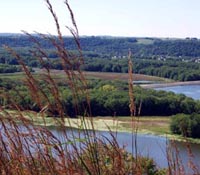Southern Lowland Forests
Community Description
The southern lowland forests of Wisconsin, as defined by Curtis' Plant Ecology Laboratory, refer to forested wetlands that include floodplains and hardwood swamps. Floodplain forests, or fluvial swamps, are associated with rivers and streams. They experience significant fluctuations in moisture levels, and they may only flood every 2-3 years or longer, usually in the spring. Hardwood swamps occupy old lake beds that formed in depressions left by receding glaciers, and they tend to be wet for most of the year due to impeded drainage.

Floodplain variation as seen from above.
Floodplain forests are notable for diverse landforms that have resulted from frequent flooding and channel migration events. Different assemblages of plant species can be observed associating with different landforms positioned along the cross-section of the floodplain. These landforms, along with the floodplain-upland transition zones, may often support a more diverse plant community than adjacent upland forest communities.
Young floodplain forests are typically occupied by black willow and cottonwood in the overstory. These short-lived species are likely replaced by silver maple and to a lesser-degree green ash and American elm. Swamp white oak is perhaps the most charismatic floodplain species, especially in forests with well-drained soils. It requires light to regenerate, and so responds well to gaps created from flooding or even occasional fires. On less frequently flooded back terraces, you will begin to see basswood, bitternut hickory, hackberry, red oak, white ash, and other more typical upland species. Many of the wetter-spectrum species mentioned above, along with black ash and slippery elm, are typical of the lacustrine swamps.

Iris virginica lights up the understory
The groundlayer of these lowland forests consists of a diverse mixture of forbs, sedges, grasses, and vines. Woody shrubs are a less frequent component of these dynamic systems, but can become quite dominant (e.g., buckthorn and prickly ash) in areas such as high terraces that have experienced a reduction in the frequency and/or duration of flooding. Head-high nettles (Laportea canadensis and Urtica dioica) are quite common in areas that are not directly subject to frequent flooding. Some of the 'jewels' of these lowland forests include cardinal flower, fringed loosestrife, and green dragon.




